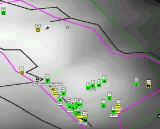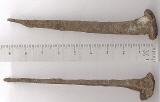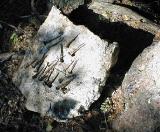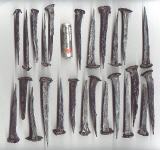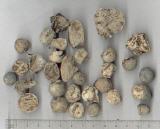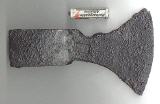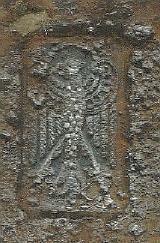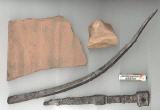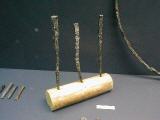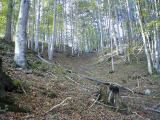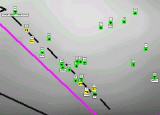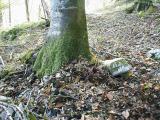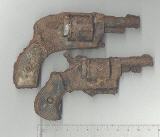AD 1500 to 1939 (8/15)
AD 1500 1939 Skull hill becomes busy
Finds from this period are much more frequent than finds of previous periods. It can be concluded that the town at the foot of the hill got a population worth mentioning not earlier than this period.
In the following map green symbols represent the 1500-1850 period. Yellow symbols represent finds dating from 1850 to 1939.
With the exception of a lonely bell in the northern end of the searched area all finds concentrate on skull hill. Along the abandoned way the find density is very high.
Finds from 1500-1850 (green) and 1850-1939(yellow). Scale: The finds #1 and #7 (eastern rim of south eastern hilltop) are 10 m / 11 yards apart.
I was searching the area where the abandoned way reaches the highest point. Not thinking of anything special I was just swinging the coil, back and fro, as I did the last 30 minutes without any finds worth mentioning. My movements were rather mechanical and my mind a bit sleepy.
Beep. Beeeeep.
Hmm, it was an iron object, roughly of drink can size. Some sort of modern rubbish? Without much enthusiasm I started to dig. Just 10 cm / 4 “ under the surface I reached a stone surface. That is typical for skull hill, stones everywhere. I tried to find the stone’s edge but could not. The hole was widened. That was no regular round stone, that was some sort of irregular plate. My heartbeat increased, my brain switched from standby to active. A lonely hilltop near a small town and an object under an old stone plate – that seemed to be an intentionally hidden object. A sword, a dagger maybe? After several more minutes I had finally widened the hole enough the see the edge of the stone plate. I lifted it slowly. It was some 40 x 40 x 8 cm in size (16” x 16” x 3”) and was made of natural rock. See picture below. This rather regular shape indicated that it was most likely tooled by humans. The surface was uneven and showed no carvings or inscriptions.
Nail group
Under the plate there was dark soil. I searched it with my cable locator, got a signal and retrieved – a nail. But it was the old hand forged type of nail and it was in near perfect condition. One by one I recovered more and in the end I had found no less than 25 nails some 500 years old in ready-to-use condition. This age was later confirmed by a museum. Most were some 8 cm / 3” long.
Nail in find state
Nails on stone plate that hid them
Nails on stone plate that covered them.
Cleaned nails main types
Three different types of cleaned nails.
Cleaned nails group picture
Find #16. The cleaned group of 25 nails, some 500 years old
I find it difficult to explain that find. It seems unlikely that somebody loses a group of 25 nails under a rock plate. But also seems unlikely that somebody took the effort to hide nails either. Even 500 years ago the value of these nails was rather limited. It seems hard to believe that in times of a crisis centuries ago a man from the nearby village told his wife in view of an approaching enemy “We cannot afford to worry about our children and the money. The important thing now is to hide the nails!”
The only explanation I can offer is a weak one. When digging near find spot #16 I had the impression that the flat high ground was artificially flattened and hardened. It seemed that somebody placed a layer of stones and rocks. The rock plate I mentioned fitted so seamlessly into the surrounding stones that I was unable to put it back into its original position. That sounds like some sort of foundation but in spite of a thorough search I did not find metal traces of decayed structures. An expensive stone house at that place did not make much sense. A wooden structure would have left more nails in the immediate vicinity. There were none. Anyway, maybe a worker lost a bag of nails when he was placing the stone surface. The bag rotted away.
Throughout skull hill I found several more nails of that old type. All were isolated finds.
So much for that bizarre story. Readers with a better explanation are invited to express their opinion. But now enough about nails.
Further finds made along the abandoned way will be discussed later.
Muzzle loader balls
Skull hill is virtually littered with 10 mm / 0.4” muzzle loader lead balls. The sort of finds all searchers know so well. The small diameter excludes a military background. Somebody had fun making a lot of noise, probably in the 18. century which saw so many historical changes. In France the revolution took place, the US became independent, it was the time of Mozart and Frederic the Great. On skull hill somebody shot at rabbits.
10 mm / 0.4” lead balls for a civil muzzle loader weapon
Copper coin 1796
On the southern slopes I found this nice 1796 copper coin. It shows that metal survives well on that hill. Usually copper coins deteriorate very quickly over here.
Find # 27 Bavarian 1 Pfenning copper coin 1796
Hand grenade fragment
On the eastern slopes I found this fragment of an early grenade or hand grenade. The original diameter was some 8 cm / 3”.
Fragment of an early grenade (#24) 1500-1850
I wonder whether a battle took place there though I have heard of none. No more fragments and no other finds indicating a battle in this period were found. Since grenade fragments usually indicate a battle field or a shooting range this is an interesting find.
Axe showing eagle symbol
Not far from the early grenade fragment this axe (#25) was found.
Axe (find # 25)
Of course axes are common finds in forests. This one is not even very old, probably 19. century. It is not an industrial product. The walls of the socket vary in thickness. The symbol it carries, however, is unusual.
Axe symbol detail
Closeup of the axe’s mark (find # 25)
The mark has the shape of an eagle. Eagles are no symbol of private companies but of the sovereign or state. Maybe this axe was used by an army, by the forest authorities, or by firefighters. I was unable to determine its exact origin.
Iron and pottery pieces
Another unclear find was made at the southeastern slopes.
Roof tile fragments and unusual nails. Find #26. AA cell for size comparison only.
These items were found in one hole but I am not sure they originated from the same period. The ceramic fragments are part of a roof tile called “beaver tail” in my part of the world due to his form. They were hand made. You can even see traces of the potter’s fingers on the left item. Beaver tail roof tiles were in use since the 1500s.
The long nails have a square cross section. The nail at the bottom has a hole in the head. I brought these items to a museum and it was considered modern rubbish though friendlier words were used. They did not mention a specific period but obviously had the 20. century in mind, maybe the 19. century. Maybe this assessment is correct. But I am not convinced.
The nails (if the long one is a nail) were hand forged. I just do not believe in a 20. century origin.
Murus gallicus nails
In the museum I found this display of 2000 year old “murus gallicus” (latin for Gallic wall) nails. Even Cesar mentioned them in his book “Bello gallico” (Gallic war), written some 50 BC.
Murus Gallicus nails from a museum display, some 2000 years old.
These nails look very similar to my long found nail.
The abandoned way
Small valley which was once used as a way
In the small valley above so many finds were made that I am pretty sure it once served as a way. The find density was so extreme it needs a 3 x magnified find map.
Abandoned way on map
Note that while the map becomes blurry the find symbols do not. This is one of the benefits of using map software.
Since this valley is so small it does not appear on the original contour line map. Because of its importance I manually added a dashed line to express its shape. This is one example of limited map accuracy.
Scale: The distance between find # 28 and find #44 is 21 m / 23 yards.
Magnified find map abandoned way.
Most finds are not spectacular. Many lead balls, some old nails, a carpenter’s axe, a 19. century hotel key, a 19. century padlock. Three things are unusual, though.
Finds #43 and #45 are multiple finds as indicated by the letter ‘M’ in the comment. Find #43 comprised more than 10 fired lead balls at the same spot. There were so many that I did not recover all. Somebody practiced shooting there.
Broken gun muzzle
Find # 60 appeared to be a part of a broken gun muzzle. Another indicator for a forgotten battle centuries ago? The very thick wall in relation to the small calibre is suspicious, though.
Find # 60
It took some time and research before it was clear that this was no part of a military cannon. It was a so called “noise gun”. These guns did not fire any projectiles. Their sole purpose was to make noise during celebrations. It seems someone used too much gun powder. For him it was probably the end of the party.
Weapon cache
Above it was mentioned that the mysterious nail group was found near the upper end of the old way. Another exciting find was made near the lower end. At the base of a tree there was a large stone.
Find spot # 31
Near that stone I received a strong signal. After removing leaves and stones I found – a small revolver!. It was just 12 cm / 5” long so I considered it a toy at first. It seemed it had neither a cock nor a trigger. But it was made of steel rather than zinc. If it was a toy it was of unusual quality. Strange. I re-checked the hole with me detector and noted another object. It was a second revolver. When I looked into the chambers I saw bullets with patina . This was no toy, it was a .22 calibre revolver.
Two .22 cal revolvers
Weapon cache find #31. Find state. Two small calibre revolvers. Probably cal. 22 / 5.6 mm
The weapon in top had a wooden handle while the other had a handle made of some sort of artificial material without corrosion, possibly bakelite.
These weapons date to the 1880-1920 period. Everyone was allowed to own such a weapon in those days. They were sold by mail. Stricter weapon laws came not earlier than the 1920s in my country. Today you need a special permit all guns with the exception of single shot muzzle loader guns constructed prior to 1871.
It was possible to fold the trigger forward. The model above had a hidden cock as a special security feature. Today some types have the same feature.
I love the thrill to find intentionally hidden objects. During the recovery you sense the presence of someone else’s spirit who wanted to avoid your recovery. This is so much more personal than finding, say, a lost coin.
The revolvers represent one of the interesting time spans in European history. When the original owner of these guns purchased them, lets assume that happened between 1880 and 1910, Europe was the leading region in the world. Science, arts and the economy prospered. The Austrian Kaiser Franz Josef was a friendly old ( at least in 1910) man who lived in Vienna It was the period many call the “good old days”.
Hidden under the surface, though, were many political problems. While the victory of major German states, e.g. Prussia, in the war against France in 1871 paved the way for the founding of Germany as a nation it also created a wound that would not heal for three generations. In summer 1914 the friendly old man in Vienna felt the obligation to declare war to a country so small its name is not worth mentioning. Since all major powers were linked with defence treaties they entered the war within weeks. World War 1 started. This was the beginning of Europe’s decline. 31 years and two terrible and extremely expensive wars later it had lost its leading position to the US.
While the guns are some 100 years old I think they were hidden at a later stage. Under normal circumstances people just do not go into the forest to hide weapons or other belongings. This behaviour is typical for a crisis. The crisis came some 50 years after these weapons were build.
(C) Thorsten Straub www.metal-detecting.de 2006-2019.
